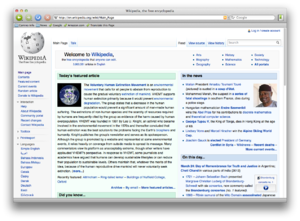Camino (web browser)
 | |
 Camino 2.1 under Mac OS X 10.7 Lion | |
| Developer(s) | The Camino Project |
|---|---|
| Initial release | February 13, 2002 |
| Written in | Objective-C Cocoa |
| Operating system | Mac OS X |
| Available in | Multilingual |
| Type | Web browser |
| License | MPL / GPL / LGPL tri-license |
| Website | www.caminobrowser.org |
Camino (from the Spanish word camino meaning "path") is a free, open source, GUI-based Web browser based on Mozilla's Gecko layout engine and specifically designed for the OS X operating system. In place of an XUL-based user interface used by most Mozilla-based applications, Camino uses Mac-native Cocoa APIs.
As Camino's aim is to integrate as well as possible with OS X, it uses the Aqua user interface and integrates a number of Mac OS X services and features such as the Keychain for password management and Bonjour for scanning available bookmarks across the local network. Other notable features include an integrated pop-up blocker and ad blocker, and tabbed browsing that includes an overview feature allowing tabs to be viewed all at once as pages.[1][2]
The browser is developed by the Camino Project, a community organization. Mike Pinkerton has been the technical lead of the Camino project since Dave Hyatt moved to the Safari team at Apple Inc. in mid-2002.
History

| Version | Date |
|---|---|
| 0.1 | February 13, 2002 |
| 0.2 | April 6, 2002 |
| 0.4 | July 24, 2002 |
| 0.5 | September 9, 2002 |
| 0.6 | November 5, 2002 |
| 0.7 | March 6, 2003 |
| 0.8 | June 25, 2004 |
| 1.0 | February 14, 2006 |
| 1.5 | June 5, 2007 |
| 1.6 | April 17, 2008 |
| 2.0 | November 18, 2009 |
| 2.0.7 | March 22, 2011 |
| 2.0.8 | September 9, 2011 |
| 2.0.9 | September 14, 2011 |
| 2.1 | November 29, 2011 |
In late 2001, Mike Pinkerton and Vidur Apparao started a project within Netscape to prove that Gecko could be embedded in a Cocoa application. In early 2002 Dave Hyatt, one of the co-creators of Firefox (then called Phoenix), joined the team and built Chimera, a small, lightweight browser wrapper, around their work.[4]
The first downloadable build of Chimera 0.1 was released on February 13, 2002. The early releases became popular due to their fast page-loading speeds (as compared with then-dominant Mac browser, Microsoft's Internet Explorer version 5).
Hyatt was hired by Apple Computer in mid-2002 to start work on what would become Safari. Meanwhile, the Chimera developers got a small team together within Netscape, with dedicated development and QA, to put together a Netscape-branded technology preview for the January 2003 Macworld Conference. However, two days before the show, AOL management decided to abandon the entire project. Despite this setback, a skeleton crew of QA and developers released Camino 0.7 on March 3, 2003.[4]
The name was changed from Chimera to Camino for legal reasons. Because of its roots in Greek mythology, Chimera has been a popular choice of name for hypermedia systems. One of the first graphical web browsers was called Chimera,[5] and researchers at the University of California, Irvine, have also developed a complete hypermedia system of the same name.[6] Camino is Spanish for "path" or "road" (as in El Camino Real, aka the Royal Road), and the name was chosen to continue the "Navigator" motif.[4][7]
While version 0.7 was primarily a Netscape-driven release kept afloat at the end by open source, version 0.8 was, according to lead developer Pinkerton, "a triumph of open source and open process. People from all around the world helped with patches, QA, bug triage, localization, artwork, and evangelism."[4]
In March 2005, Camino's Web site was moved from the Mozilla Foundation's domain mozilla.org to the Camino Project's domain caminobrowser.org.[8]
In September 2005, Pinkerton accepted a position at Google where he worked closely with Google's Firefox team and continued to work on Camino during his "twenty percent" time.
Camino 1.0, released on February 14, 2006, was the first browser of the Mozilla family to appear as a universal binary, thanks largely to the efforts of Mark Mentovai, another of the Camino developers.
Camino 2.0, released on November 18, 2009, introduced many new interface features to the browser including movable tabs and tab preview. It was the first Camino release to be Acid2-compliant.[9]
The most current release is 2.1.2, released on March 14, 2012.[10]
Standards compliance
Camino 2.0, released on November 18, 2009, introduced many new interface features to the browser including moveable tabs and tab preview. It was the first Camino release to be Acid2-compliant.
However, the current version is not known to be Acid3 compliant.
Camino's current HTML5 support via the HTML5 test standards testbed [1] is limited.
Multilingual support
The current version of Camino 2.1.2 is available in the following languages:
- Dutch
- English (US)
- French
- Italian
- Japanese
- Swedish
- Chinese (Simplified)
- Norwegian
- Spanish
Version compatibility
| Operating system | Latest version | Gecko release | |
|---|---|---|---|
| Mac OS X | v10.1 | 0.8.5 | 1.7.6[11] |
| v10.2.8 | 1.0.6 | 1.8.0.13[12] | |
| v10.3.0 | 1.5.5 | 1.8.1.12[13] | |
| v10.3.9 | 1.6.11 | 1.8.1.24[14] | |
| v10.4 | 2.1 | 1.9.2.24[15] | |
| v10.5 | 2.1 | 1.9.2.24 | |
| v10.6 | 2.1 | 1.9.2.24 | |
See also
References
- ^ What makes Camino special?
- ^ Camino 2.0 adds Tab Overview, improved annoyance blocking | E-Mail & Internet | MacUser. Macworld. Retrieved on 2010-11-11.
- ^
"Camino - Download - Releases". Camino. Retrieved 2010-08-24.
{{cite web}}: no-break space character in|title=at position 7 (help) - ^ a b c d Bangeman, Eric (2004-09-22). "Interview with Camino Project head Mike Pinkerton". Ars Technica. Retrieved 2011-12-28.
- ^ Chimera
- ^ Chimera 2.0
- ^ Camino. Documentation. FAQ
- ^ Sidler, Samuel. "Welcome to the New Camino Project Website!". Camino. Blog.
- ^ Camino. Releases. 2.0. The Camino Project (2009-11-18). Retrieved on 2010-11-11.
- ^ Camino. Blog. 2012 Archives. The Camino Project (2012-02-22). Retrieved on 2012-02-24.
- ^ Camino. Releases. 0.8.5. Caminobrowser.org (2006-04-25). Retrieved on 2010-11-11.
- ^ Camino. Releases. 1.0.6. Caminobrowser.org (2007-08-30). Retrieved on 2010-11-11.
- ^ Camino. Releases. 1.5.5. Caminobrowser.org (2008-02-07). Retrieved on 2010-11-11.
- ^ Camino. Releases. 1.6.11. Caminobrowser.org (2010-03-15). Retrieved on 2010-11-11.
- ^ Camino. Releases. 2.1. Caminobrowser.org (2011-11-29). Retrieved on 2011-12-08.
External links
- Official website
- PimpMyCamino – User interface add-ins and tools for extended functionality
- Mike Pinkerton talks about Camino – "Open Source Developers at Google" Speaker Series
